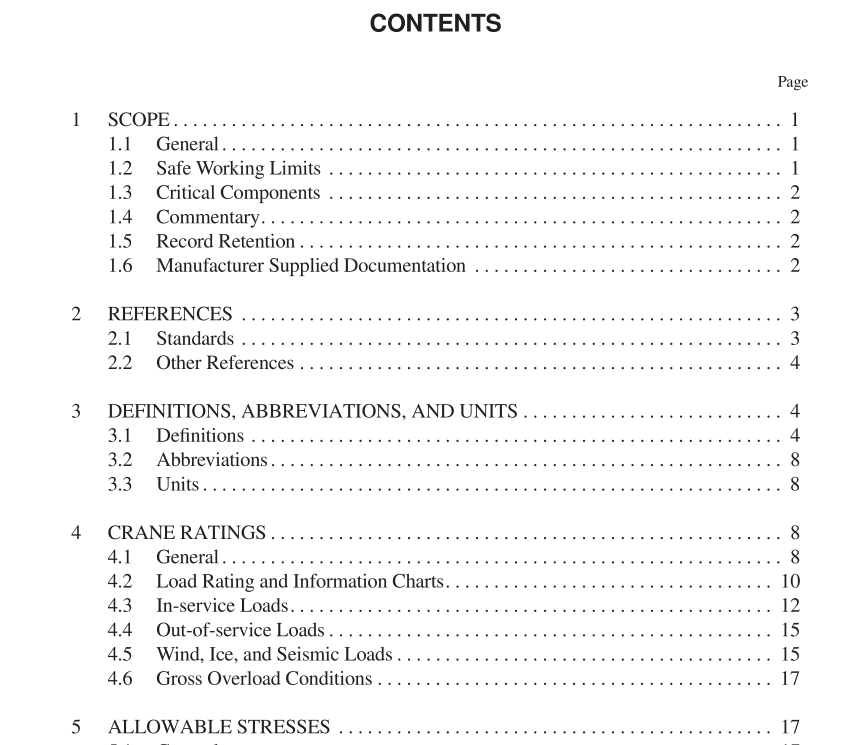API Spec 2C pdf download

API Spec 2C pdf download.Specification for Offshore Pedestal Mounted Cranes
1 Scope
1.1 GENERAL
This specification details the requirements for design, con- struction, and testing of offshore pedestal mounted cranes. Offshore cranes are defined herein as pedestal mounted ele- vating and rotating lift devices of the types illustrated in Fig- ure 1 for transfer of materials or personnel to or from marine vessels and structures. Offshore cranes are typically mounted on a fixed (bottom supported) or floating platform structure used in drilling and production operations. API Spec 2C is not intended to be used for the design, fabrication, and testing of davits and/or emergency escape devices. API Spec 2C is also not intended to be used for shipboard cranes or heavy lift cranes. Shipboard cranes are mounted on surface type vessels and are used to move cargo, containers, and other materials while the crane is within a harbor or sheltered area. Heavy lift cranes are mounted on barges or other vessels and are used in construction and salvage operations within a harbor or shel- tered area or in very mild offshore environmental conditions.
1.2 SAFE WORKING LIMITS
The intent of this specification is to establish safe working limits for the crane in anticipated operations and conditions. This is accomplished by establishing Safe Working Loads (SWLs) based on allowable unit stresses and design factors. Operation of the crane outside of the limits established by the manufacturer in accordance with the guidelines set forth in this document can result in catastrophic failure up to and including separating the entire crane and operator from the foundation. Compliance with the allowable stresses and design factors set forth in this specification does not guaran- tee that the crane will not be dismounted from its foundation in the event of a gross overload such as might occur in the event of snagging the supply boat.
3 Definitions, Abbreviations, and Units
3.1 DEFINITIONS 3.1.1 A-frame: See gantry , also known as mast (see Figure 1, item 18). 3.1.2 allowable rope load: The “nominal” breaking strength of the rope divided by a design factor. 3.1.3 auxiliary hoist: See whip line (see Figure 1, item 27). 3.1.4 axis of rotation: The vertical axis around which the crane upper-structure rotates. 3.1.5 base (mounting): See pedesta l (see Figure 1, item 24). 3.1.6 bearing raceway: The surface of the bearing rings which contact the rolling element (balls or rollers) of the swing-bearing assembly. 3.1.7 bearing ring: The rotating and stationary rings that house the rolling elements (balls or rollers) of the swing-bear- ing assembly. 3.1.8 boom: A member hinged to the revolving upper- structure and used for supporting the hoist tackle. 3.1.9 boom angle: The angle above or below horizontal of the longitudinal axis of the base boom section. 3.1.10 boom angle indicator: An accessory which measures the angle of the boom above horizontal. 3.1.11 boom chord: A main corner member of a lattice type boom (see Figure 1, item 1). 3.1.12 boom extension: Intermediate section of a tele- scoping boom (see Figure 1, item 2). 3.1.13 boom foot-pin: The boom pivot point on the upper-structure (see Figure 1, item 3).3.1.14 boom hoist: See Section 8.2 and its sub-sections. The hoist mechanism responsible for raising and lowering the boom. 3.1.15 boom hoist mechanism: Means for supporting the boom and controlling the boom angle (see Figure 1, item 4). 3.1.16 boom hoist wire rope: Wire rope that operates on a drum controlling the angle positioning of the boom (see Figure 1, item 5). 3.1.17 boom lacing: Structural truss members at angles to and supporting the boom chords of a lattice type boom (see Figure 1, item 6). 3.1.18 boom length: The straight-line distance from the centerline of boom foot-pin to the centerline of the boom- point load hoist sheave pin, measured along the longitudinal axis of the boom. 3.1.19 boom lift-cylinder: Means for supporting the boom and controlling the boom angle (see Figure 1, item 7). 3.1.20 boom line: Boom hoist rope that reels on drums or passes over sheaves. See boom hoist wire rope. 3.1.21 boom-point sheave assembly: An assembly of sheaves and a pin built as an integral part of the boom-point (see Figure 1, item 8). 3.1.22 boom splices: Splicing connections for sections of basic crane boom and additional sections usually of the splice plate type, pin type, or butt type (see Figure 1, item 12). 3.1.23 boom stop: A device used to limit the angle of the boom at the highest recommended position (see Figure 1, item 13).









